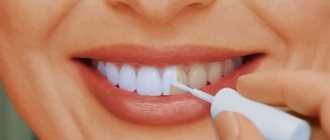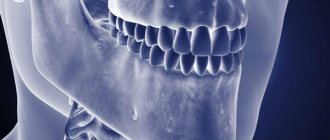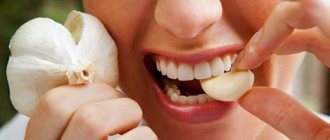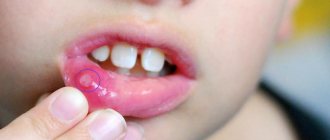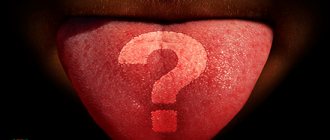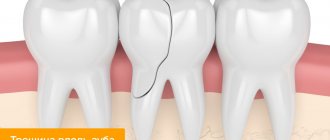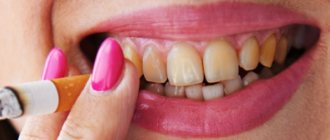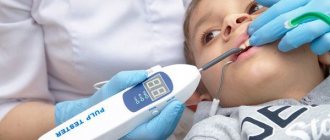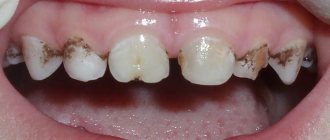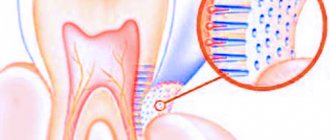Author of the article:
Soldatova Lyudmila Nikolaevna
Candidate of Medical Sciences, Professor of the Department of Clinical Dentistry of the St. Petersburg Medical and Social Institute, Chief Physician of the Alfa-Dent Dental Clinic, St. Petersburg
Many people cannot imagine their morning without a hot, invigorating drink. It seems that coffee can work wonders and literally bring you back to life. Gradually, the body gets used to any influence, so in order to invigorate you need more and more cups of this fragrant savior. But at some point we notice that the teeth acquire an increasingly intense yellow, and in some places even a brown tint.
What to do? Sound the alarm? Give up your favorite drink? Or should you put up with the picturesque patterns on your tooth enamel and just stop smiling?
All this, of course, is not an option. Moreover, today there are many ways to maintain healthy and white teeth without changing your habits. Let's figure out how coffee affects teeth, consider the most popular and effective methods that help get rid of plaque.
Is coffee harmful to teeth, does it destroy them?
Harm of coffee to tooth enamel
- The opinion that coffee has a negative effect on teeth has been refuted by recent scientific research.
- Adverse effects occur. But no more than from eating any other food.
- Compliance with basic hygiene rules and proper intake of the drink are the basis for healthy and white teeth for lovers of this natural tonic.
- Moreover, the results of the latest research by scientists at an Italian university have proven the benefits of coffee for the prevention of caries. The antibacterial components of the drink do not allow bacteria to linger on the surface of the teeth.
- Similar experiments were carried out by American specialists. As a result of the work, elements of chlorogenic and nicotinic acids were identified, which prevent the formation of microbes that develop caries.
- It is also believed that the chemical composition of caffeine helps prevent cancer of the throat and oral cavity. Natural coffee drinkers are 60% less susceptible to these health problems.
How does coffee affect tooth enamel?
In order to understand how coffee affects teeth, you need to compare the factors of the positive and negative effects of this drink, and then draw conclusions for yourself.
Positive effects of coffee:
- the presence of antioxidants helps prevent the development of inflammatory processes in the oral cavity;
- it does not contain aggressive acids, unlike carbonated drinks that destroy tooth enamel;
- drinking 1-2 cups a day helps reduce the development of dental bone tissue atrophy;
- the bactericidal properties of the drink, the presence of catechins and their derivatives in it does not allow bacteria to linger on the enamel, which prevents the development of caries;
- It is believed that the chemical composition of caffeine helps prevent the development of malignant tumors of the mouth and throat.
All of the above applies only to natural coffee drinks, which do not contain cream, sugar, etc.; the effect of these components on tooth enamel is considered separately.
Among the negative factors, the following are noted:
- staining of the enamel, this occurs due to the presence of microcracks in it, in which coffee remains; if the teeth are healthy, then there is nothing to be afraid of;
- adding sugar to a drink negatively affects the condition of your teeth, try drinking unsweetened coffee, this will reveal its taste much better;
- Drinking a hot drink outside in cold weather leads to the appearance of microcracks in the enamel, which arise due to a large temperature difference.
Based on the described qualities of coffee, it is clear that its moderate and correct intake does not lead to the formation of coffee plaque and does not harm the enamel. A natural and unsweetened drink, consumed in moderation, is not hazardous to health. The danger is sugar, which, remaining on the enamel, is a breeding ground for bacteria, which leads to the development of caries.
It is not recommended to drink any hot liquids in the cold, wash them down with cold water or eat ice cream.
If you drink more than 4 cups of this drink a day, then in addition to yellowed enamel, other problems may appear:
- weight gain, because metabolism slows down;
- overload of the nervous system;
- weakened immunity;
- malfunctions of the thyroid gland.
Scientists conducted an experiment in which completely healthy teeth were placed in different liquids for 10 days. After this, the condition of the enamel of each specimen was examined under a microscope. The one that was in coffee changed the least: the pigmentation of the enamel practically did not change, there was no disorientation of the dentinal tubules, and their narrowing occurred in isolated cases. The experiment was carried out in laboratory conditions, and people often have microcracks in their enamel, caries, etc., so the results will be different.
Why do teeth turn yellow and dark from coffee?
Does coffee drink make teeth yellow?
Drinking a small amount of the drink will not cause a big change in the color of your teeth. Since coffee beans contain natural dyes, it becomes more difficult for those who drink coffee excessively to keep their teeth white.
In this case, tooth enamel staining occurs due to microcracks formed in it. If you take care of your teeth and take care of them, there is no need to worry about discoloration.
- Those who like to drink hot coffee outdoors in cool weather or combine coffee with ice cream should be careful. Contrasting temperature is one of the causes of enamel destruction. Coffee, getting into the cracks formed, gives the teeth an undesirable shade.
- After any meal, plaque remains on the teeth. If it is not removed promptly, it accumulates on the surface of the teeth. This layer, like a sponge, is saturated with the dark color of coffee, and it is this layer that gives the enamel its yellowness.
How to avoid plaque?
If you are a big fan of this drink, but want to ensure that coffee stains never appear on your teeth, you should adhere to the following recommendations:
- due to the fact that the enamel turns yellow due to the presence of microcracks in it, it is necessary to monitor the condition of the teeth;
- drink the drink through a straw, this solution helps reduce the contact of the enamel with the liquid consumed;
- Low caffeine coffee contains less coloring matter;
- after each coffee procedure, you should rinse your mouth with warm water;
- drink quickly so that the drink does not linger long in the mouth;
- coffee brewed in a Turk will contain more polyphenols than coffee brewed in an espresso machine;
- To prevent your teeth from turning yellow, after each meal you need to brush not only them, but also your tongue, otherwise the bacteria on it will negatively affect the condition of the enamel.
Stains, plaque from coffee on teeth: how to whiten with folk remedies?
Many options for whitening tooth enamel
If plaque is not too large, you can remove it yourself.
Using folk remedies:
- baking soda into the hard tissue of your teeth with a toothbrush or cotton swab. Rinse your mouth with warm water.
- Grind the activated carbon . Rinse your mouth. Brush your teeth with charcoal as usual.
- Brush your teeth and rinse with peroxide . Repeat the procedure for 2 weeks. Be careful. Bleaching in this way can lead to partial dissolution of the enamel.
- Rub strawberry, apple or lemon peel . Brush them with fluoride toothpaste. Use this type of whitening no more than once every two weeks. The acid contained in these products can lead to thinning of the enamel.
Consultation with a hygienist
Before this appeal, the young man had never been to a hygienist, but he had heard from friends that with the help of professional teeth cleaning you can remove the most stubborn stains without damaging the enamel. Hygienist Tatyana Kondratyeva conducted an examination and found out that the young man does not smoke, but drinks a lot of coffee. Dark spots on teeth are pigmented plaque. Pigments from coffee and strong tea stain hard plaque on teeth, and these stains are very difficult to clean with home remedies.
Tartar has formed on the inner surface of the teeth, which presses the gums away from the teeth, opening the path for infection to the roots of the teeth, disrupting blood circulation in the gums. Tartar is the cause of bad breath.
The hygienist applied a plaque indicator to the patient's teeth to determine the effectiveness of self-hygiene.
Purple staining along the gums indicates that these areas need to be cleaned more thoroughly. The front teeth are slightly larger than the adjacent ones, so the young man does not grab the tops of the teeth when brushing. You need to pay more attention to these places, making sweeping movements with the brush when cleaning, from the gums to the edges of the teeth, grabbing the surface of the gums too.
Determining the acidity of saliva helps identify the risk of developing caries and the need for more frequent visits to the dentist for examination. In this case, the acidity of saliva is slightly alkaline, there is no increased risk of caries.
Stains and stains from coffee on teeth: how to whiten with products from the pharmacy?
Pharmacy products:
- Whitening toothpastes in combination with hard brushes.
- An electric toothbrush. High speed allows you to thoroughly clean your teeth in a short time from fresh yellow plaque.
- Whitening strips . An effective, but very expensive method. For whitening, just stick the strips on your teeth and leave them on for 30 minutes. The result is achieved after 2 weeks of use.
- Teeth whitening gels . Safe and affordable product. Apply to clean teeth. The gel will gradually dissolve. Apply daily until the desired result is achieved. But no more than 2 weeks in a row.
- Whitening trays. A very effective remedy. Whitens the oldest yellow stains. Should be used very carefully. Strictly according to the instructions. An overdose can lead to the destruction of enamel.
- Whitening sticks. Mild whitening agent. More suitable for preventing plaque. Used most often after drinking coffee directly to remove fresh plaque.
Effective ways to remove coffee stains
First of all, this is a professional cleaning, which is done once every 3 months (your dentist will tell you for sure). There are ultrasonic whitening and abrasive Air Flow. They effectively remove plaque and restore the natural color of the enamel.
For your home, you can buy yourself an ultrasonic brush that will effectively remove deposits and prevent pigments from attaching to the enamel.
As a last resort, if conventional methods of removing plaque do not help, you can undergo teeth whitening and then carefully monitor the condition of your oral cavity.
- Black coffee can indeed cause yellowing of enamel;
- Hot coffee with high acidity causes stains and deposits to appear more quickly;
- It is necessary to clean plaque, it is not only aesthetics, but also general health;
- An ultrasonic toothbrush helps millions of people maintain clear enamel color.
How to drink coffee so your teeth don't turn yellow?
Can you enjoy coffee through a straw?
As mentioned above, the main reason for discoloration of enamel is plaque and microcracks.
Therefore, only thorough prevention will help prevent yellowing of teeth:
- Avoid contrasting coffee with ice cream or cold water.
- Brush your teeth after every drink.
- Use dental floss to thoroughly clean the crevices between your teeth.
- If you don’t have the conditions to brush your teeth after coffee, eat an apple. It perfectly cleanses the surface of teeth from fresh plaque stained by drinking coffee.
- Chew gum with a whitening effect after drinking coffee. This will help to at least briefly delay the proliferation of microbes that contribute to the appearance of plaque on the teeth.
- Use a teeth rinse for the same purpose.
- Wash your coffee with soft water. It will wash away the pigment and prevent the appearance of unsightly plaque.
What is more harmful: coffee or tea?
There is an opinion that tea is less harmful than a coffee cocktail. In fact, both drinks contain about the same amount of caffeine. This is discussed in detail in the article “Where is there actually more caffeine: in coffee or tea? Let's count."
From this we can conclude that the coloring effect of coffee and tea will be the same. The latter will also intensify if, after drinking, you rinse your mouth with preparations containing chlorhexidine.
Is it possible to drink coffee immediately after brushing and whitening your teeth and how much should you not?
White teeth after brushing, won't coffee hurt?
- To maintain a snow-white smile for as long as possible after teeth whitening, avoid any products that can stain your teeth.
- Since coffee contains natural dyes, avoid drinking it for 2 days. Subsequently, for 2 weeks, reduce the consumption of your favorite drink to a minimum.
- After this time, you can return to your normal routine of enjoying aromatic coffee.
Coffee and healing procedures
After filling or implants, there are usually no restrictions on drinking espresso, but be sure to consult with your doctor.
Interesting! How many cups of coffee can you drink per day?
But keep in mind that the filling material may be stained. Especially at first. Therefore, it is better to refrain from pure coffee. It is better to add milk during the day.
After tooth extraction, you can drink coffee within a few hours. But it is important to remember that it must be warm.
But before removal, drinking the drink is prohibited. This is due to the fact that caffeine weakens the effect of anesthesia.
Video: Plaque on teeth. Why do teeth turn yellow?
- When and at what age should you start brushing your child’s teeth: advice from dentists.
- How to keep your teeth white: rules, dental advice for white teeth
- The best toothpastes that remove tartar: rating.
- A healthy tooth hurts: reasons. Why does a healthy wisdom tooth hurt when pressed after treatment?
- Is it worth it and how to treat a wisdom tooth: tips, reviews, complications
- How to relieve tooth sensitivity at home?
- Pain after removal of a nerve or tooth: causes, treatment.
- How many teeth does an adult have in his mouth normally - Anatomy
- How to strengthen gums if teeth are loose due to periodontal disease, gingivitis, periodontitis?
- Swollen cheek after tooth extraction, what to do?
- Lunar calendar for dental treatment: table.
- Malocclusion in adults. How to straighten teeth?
- Inflammation of the gums: signs and causes, treatment with medications and folk remedies, prevention
- Teeth whitening. How to whiten teeth at home?
- How to remove plaque on teeth? How to remove plaque at home?
- What are veneers? Veneers on teeth: pros and cons, before and after photos
- Stains, coffee stains on teeth: how to whiten? How to drink coffee so your teeth don't turn yellow?
Why do stains appear on teeth?
It’s not just this drink that causes stains on your teeth. Black tea, red wine, colored soda and fruit juices have the same properties. If the enamel is healthy and smooth, then dark spots practically do not form. Pigments are deposited in porous enamel, as well as in its chips and cracks. For this reason, spots appear. Freeze-dried coffee has a greater coloring effect compared to natural coffee. If your teeth have darkened, then it’s time to think about their health and see a dentist to strengthen the enamel.
How to whiten your teeth
Approximately 85% of plaque is removed with a regular brush and toothpaste. But this only applies to teeth with healthy enamel and if plaque is removed daily. If you don't brush your teeth regularly and don't take good care of your oral cavity, hard plaque forms, which can only be removed with the help of a dentist. Currently, there are many whitening pastes, folk remedies to combat plaque, and professional types of dental cleanings.
There are many tooth whitening toothpastes, for example:
- Colgate Optic White.
- "New Pearl - Whitening."
- "Blendamed 3D White LUXE".
- "SILCA Arctic White".
- "ROCS - Sensational whitening."
These products, when used regularly, are quite effective in combating dye deposits. To enhance the effect of the paste, you can use an electric brush. And also use special products to remove plaque.
These include:
- whitening gel;
- whitening strips;
- sticks;
- trays with whitening composition;
- pencil.
These products are used to remove fresh plaque. To remove yellow plaque, many traditional methods are used. The most popular of them:
- turmeric powder mixed with a little water;
- the inside of a banana skin;
- tea tree oil;
- strawberry, pear or apple pulp;
- lemon juice;
- hydrogen peroxide three percent;
- powdered activated carbon;
- baking soda.
These substances are simply wiped over the surface of the teeth or the enamel is treated with them using a brush. If you are unable to cope with plaque on your own, it is recommended to contact a dental clinic.
The dental clinic offers various plaque removal procedures:
- chemical bleaching using high concentrations of hydrogen peroxide;
- ultrasonic removal;
- clarification using air-imaging systems;
- laser photobleaching;
- ultraviolet Zoom whitening with activating gel.
People with a thin layer of enamel or increased sensitivity of teeth should refrain from such activities.
